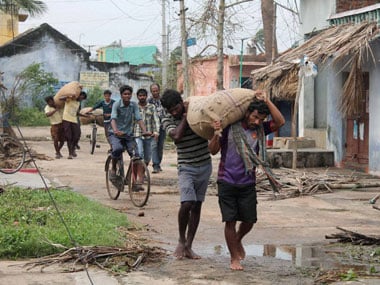Much well-deserved praise has been heaped upon Odisha chief minister Naveen Patnaik and his government’s bureaucrats for a crisis handled exceedingly well, with casualties from Phailin minimised and rehabilitation efforts already initiated. Much of this success has been attributed to learnings from the catastrophe of the 1999 Odisha cyclone. But if that disaster was a lesson for the local administration, it’s perhaps all the more reason that this weekend’s tremendously successful preventive evacuation and other efforts by the same state government be taken not as a model template but as an important milestone on the learning curve, not as a congratulatory note to the Naveen Patnaik government but as an indicator of what other successes may be achieved in future disasters. [caption id=“attachment_117052” align=“alignleft” width=“380”]  Relief material has begun to be distributed. PTI[/caption] This time, the Met department had what will be a very satisfying victory in a duel of sorts with experts from international agencies who had predicted a supercyclone that would bring as much destruction as Katrina did. Others pitched in too – warnings were issued on time, were heeded by the first responders at village levels and local government agencies. An editorial in The Times of India points out that such an effort was clearly missing in the wake of July’s Uttarakhand disaster. A well-coordinated plan worked effectively, the editorial says, pointing to another lesson well learnt, one that other state governments would do well to replicate. “It pays to ensure that disaster management staff are trained in advance and acquire sufficient and necessary skills to tackle emergencies." Clearly, in the aftermath of 1999, Odisha has learnt several critical lessons on disaster management – the floods of 2011 saw about 100 casualties but it was clear even then that small steps had been taken towards better weather monitoring, formalising standard operating procedures, coordination among various agencies, mass evacuations, preparation of cyclone relief spaces and more – all factors that led to the government minimising casualties caused by Phailin. Writing in The Indian Express, Member of Parliament Baijayant Jay Panda argues that the one thing that stood out the most amid the devastation left behind by the super cyclone of 1999 was the ineptitude of the state government, which “appeared unprepared and taken mostly by surprise”. So, at least some of the gains seen now have clearly been achieved by the district-level administration and state bureaucracy due to the stable leadership of CM Naveen Patnaik of the BJD, the party Panda represents, he writes. “In the past decade, several regional political leaders have turned upside down the old conventional wisdom that anti-incumbency invariably causes ruling parties to lose elections. This has primarily been linked to a corresponding improvement in governance, measured both by widespread acclaim as well as corroborated by socio-economic indicators. Odisha has been one of the prime examples of this phenomenon, with a three-time chief minister looking poised to lead his party to yet another electoral victory…” he writes. Such standards should not be just made an example – they should be made the standard bare minimum response. Through sustained efforts, if Odisha has undertaken capacity building for such a response, then it is essential that such capacity building become the statute everywhere else, to respond to disasters such as Uttarakhand or temple stampedes.
The devastation caused by the 1999 supercylone was taken as a lesson by the Odisha government with great success. Now the success of the response to Phailin must be taken as a lesson too.
Advertisement
End of Article


)

)
)
)
)
)
)
)
)



